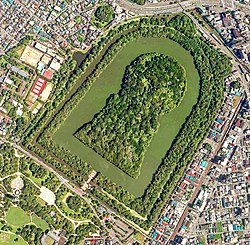
Back Kofun-tydperk Afrikaans فترة كوفون Arabic Kofun dövrü Azerbaijani Кафун Byelorussian Кофун Bulgarian কোফুন যুগ Bengali/Bangla Període Kofun Catalan Období Kofun Czech Kofun-Zeit German Kofun-epoko Esperanto
| Part of a series on the |
| History of Japan |
|---|
 |
The Kofun period (古墳時代, Kofun jidai) is an era in the history of Japan from about 300 to 538 AD (the date of the introduction of Buddhism), following the Yayoi period. The Kofun and the subsequent Asuka periods are sometimes collectively called the Yamato period. This period is the earliest era of recorded history in Japan, but studies depend heavily on archaeology since the chronology of historical sources tends to be distorted. The word kofun is Japanese for the type of burial mound dating from this era.
It was a period of cultural import. Continuing from the Yayoi period, the Kofun period is characterized by influence from China and the Korean Peninsula; archaeologists consider it a shared culture across the southern Korean Peninsula, Kyūshū and Honshū.[1] On the other hand, the most prosperous keyhole-shaped burial mounds in Japan during this period were approximately 5,000 in Japan from the middle of the 3rd century in the Yayoi period to the 7th century in the Asuka period, and many of them had huge tombs,[2][3] but in the southern Korean Peninsula there were only 13 from the 5th century to the 6th century, and the tombs were small. Wall decorations and Japanese-style armor, which are characteristic of older Japanese burial mounds, were excavated from 5th century burial mounds in the southern Korean Peninsula. This shows that Japan and the southern Korean Peninsula influenced each other.[4][5]
According to the Nihon Shoki, Buddhism and the Chinese writing system were introduced near the end of the period from Baekje. The Kofun period recorded Japan's earliest political centralization, when the Yamato clan rose to power in southwestern Japan, established the Imperial House, and helped control trade routes across the region.[6]
- ^ Barnes, Gina L. The Archaeology of East Asia: The Rise of Civilization in China, Korea and Japan (Oxford: Oxbow books, 2015), 271-275; 331-360
- ^ Kazuo Hirose (March 2009). "A consideration of reconstructing our image of the Kofun period: does the period of keyhole tombs predate the Ritsuryo state?". 国立歴史民俗博物館研究報告 = Bulletin of the National Museum of Japanese History. 150. Bulletin of the National Museum of Japanese History. doi:10.15024/00001685. Archived from the original on 8 February 2022.
- ^ Kazuo Yanagisawa (2007). "前方後円墳". 東アジア考古学辞典. Tokyodo Shuppan. ISBN 978-4490107128.
- ^ Kanta Takata. "An Analysis of the Background of Japanese-style Tombs Builtin the Southwestern Korean Peninsula in the Fifth and Sixth Centuries". Bulletin of the National Museum of Japanese History. Archived from the original on 4 April 2022.
- ^ Park Cheon-Soo (March 2010). 朝鮮半島南部に倭人が造った前方後円墳 : 古代九州との国際交流. Archived from the original on 4 April 2022.
- ^ Denoon, Donald et al. (2001). Multicultural Japan: Palaeolithic to Postmodern, p. 107., p. 107, at Google Books